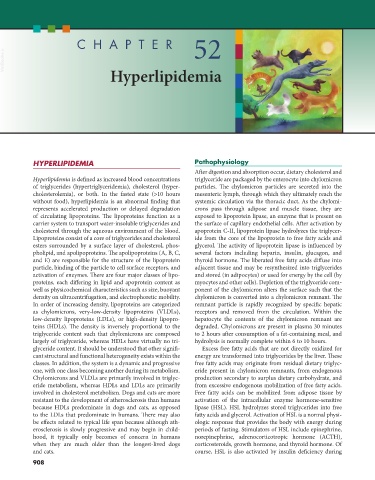Page 936 - Small Animal Internal Medicine, 6th Edition
P. 936
908 PART VII Metabolic and Electrolyte Disorders
CHAPTER 52
VetBooks.ir
Hyperlipidemia
HYPERLIPIDEMIA Pathophysiology
After digestion and absorption occur, dietary cholesterol and
Hyperlipidemia is defined as increased blood concentrations triglyceride are packaged by the enterocyte into chylomicron
of triglycerides (hypertriglyceridemia), cholesterol (hyper- particles. The chylomicron particles are secreted into the
cholesterolemia), or both. In the fasted state (>10 hours mesenteric lymph, through which they ultimately reach the
without food), hyperlipidemia is an abnormal finding that systemic circulation via the thoracic duct. As the chylomi-
represents accelerated production or delayed degradation crons pass through adipose and muscle tissue, they are
of circulating lipoproteins. The lipoproteins function as a exposed to lipoprotein lipase, an enzyme that is present on
carrier system to transport water-insoluble triglycerides and the surface of capillary endothelial cells. After activation by
cholesterol through the aqueous environment of the blood. apoprotein C-II, lipoprotein lipase hydrolyzes the triglycer-
Lipoproteins consist of a core of triglycerides and cholesterol ide from the core of the lipoprotein to free fatty acids and
esters surrounded by a surface layer of cholesterol, phos- glycerol. The activity of lipoprotein lipase is influenced by
pholipid, and apolipoproteins. The apolipoproteins (A, B, C, several factors including heparin, insulin, glucagon, and
and E) are responsible for the structure of the lipoprotein thyroid hormone. The liberated free fatty acids diffuse into
particle, binding of the particle to cell surface receptors, and adjacent tissue and may be resynthesized into triglycerides
activation of enzymes. There are four major classes of lipo- and stored (in adipocytes) or used for energy by the cell (by
proteins, each differing in lipid and apoprotein content as myocytes and other cells). Depletion of the triglyceride com-
well as physicochemical characteristics such as size, buoyant ponent of the chylomicron alters the surface such that the
density on ultracentrifugation, and electrophoretic mobility. chylomicron is converted into a chylomicron remnant. The
In order of increasing density, lipoproteins are categorized remnant particle is rapidly recognized by specific hepatic
as chylomicrons, very-low-density lipoproteins (VLDLs), receptors and removed from the circulation. Within the
low-density lipoproteins (LDLs), or high-density lipopro- hepatocyte the contents of the chylomicron remnant are
teins (HDLs). The density is inversely proportional to the degraded. Chylomicrons are present in plasma 30 minutes
triglyceride content such that chylomicrons are composed to 2 hours after consumption of a fat-containing meal, and
largely of triglyceride, whereas HDLs have virtually no tri- hydrolysis is normally complete within 6 to 10 hours.
glyceride content. It should be understood that other signifi- Excess free fatty acids that are not directly oxidized for
cant structural and functional heterogeneity exists within the energy are transformed into triglycerides by the liver. These
classes. In addition, the system is a dynamic and progressive free fatty acids may originate from residual dietary triglyc-
one, with one class becoming another during its metabolism. eride present in chylomicron remnants, from endogenous
Chylomicrons and VLDLs are primarily involved in triglyc- production secondary to surplus dietary carbohydrate, and
eride metabolism, whereas HDLs and LDLs are primarily from excessive endogenous mobilization of free fatty acids.
involved in cholesterol metabolism. Dogs and cats are more Free fatty acids can be mobilized from adipose tissue by
resistant to the development of atherosclerosis than humans activation of the intracellular enzyme hormone-sensitive
because HDLs predominate in dogs and cats, as opposed lipase (HSL). HSL hydrolyzes stored triglycerides into free
to the LDLs that predominate in humans. There may also fatty acids and glycerol. Activation of HSL is a normal physi-
be effects related to typical life span because although ath- ologic response that provides the body with energy during
erosclerosis is slowly progressive and may begin in child- periods of fasting. Stimulators of HSL include epinephrine,
hood, it typically only becomes of concern in humans norepinephrine, adrenocorticotropic hormone (ACTH),
when they are much older than the longest-lived dogs corticosteroids, growth hormone, and thyroid hormone. Of
and cats. course, HSL is also activated by insulin deficiency during
908

